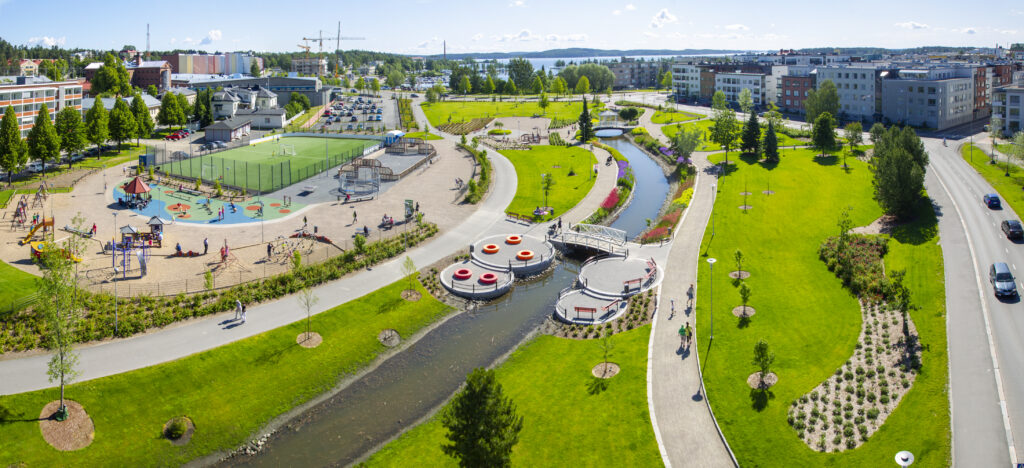Regional cooperation

Kuopio collaborates actively with neighbouring municipalities. Regional cooperation creates ideas, utilises existing good practices, supports the preparation of development projects, keeps municipalities up to date with changes in legislation, helps disseminate new information, and provides the city and the region with good examples to support a sustainable and viable community structure. The focus is on collaborative solutions and strengthening the vitality and competitiveness of the region as a whole.
The broader objective of regional cooperation in Kuopio is to promote not only the development and mutual coordination of land use, housing and transport, but also lobbying, business activities, employment services, and municipal service cooperation.
Land use, housing and transport agreement
The agreement between the Kuopio region and the state on land use, housing and transport was concluded in September 2021. The agreement gives Kuopio the profile of a major urban region. Similar agreements have previously been made with the Helsinki, Tampere, Turku, and Oulu regions. The agreement has supported cooperation between municipalities and the state in the steering of urban structure and the coordination of land use, housing, and transport. It defined concrete objectives and measures concerning land use, housing, and the development of the transport system for 2021–2023, which require cooperation between municipalities and between municipalities and the state. The agreement period will last until 2031.
In addition to Kuopio, the land use, housing and transport agreement of the Kuopio region includes Siilinjärvi, Leppävirta, Lapinlahti, Suonenjoki, and Tuusniemi. You can read statistical information about the municipalities in the Kuopio region in the document below.
Kuopio region statistics (pdf, in Finnish)
Already a short period has shown that the land use, housing and transport agreement has been a good and necessary tool for promoting cooperation between municipalities as well as between municipalities and the state. The agreement will provide the region with more investments in sustainable urban structure and low-carbon mobility. The aim is to build climate wise urban areas, increase housing production in easily accessible areas, and increase the share of sustainable modes of transport, such as public transport. The agreements support the vitality of urban regions and the flexible organisation of everyday life. Attention will also be paid to the diversity of housing stock, the road safety of residential areas, and the increased accessibility of workplaces and services.
The agreement has created a functional and coordinated regional operating model, and regional cooperation has become more active and effective.
The entire agreement is available in Finnish on the website of the Ministry of the Environment. More detailed information (in Finnish) on the monitoring of the implementation of the 39 sections of the agreement can be found in the document below.
Land use, housing and transport agreement monitoring (pdf, in Finnish)

Kuopio Urban Area Plan
Key regional successes include, in particular, the completion of the Kuopio Urban Area Plan and the Kuopio region transport system plan. The Kuopio Urban Area Plan 2030+ was prepared for the municipalities included in the land use, housing and transport agreement (Kuopio, Siilinjärvi, Lapinlahti, Suonenjoki, Leppävirta, Tuusniemi). A structural model for the functional urban region of Kuopio, LOIKKA 2030, was prepared in 2012. It presents the desired direction for the development of land use.
In the current plan, the contents of the previously prepared structural model were reviewed, prioritising the key objectives of the land use, housing and transport agreement’s plans. These include responding to climate challenges and promoting the carbon neutrality of communities. The Urban Area Plan represents the strategic intent of the agreement’s municipalities for the region’s development.
The Kuopio Urban Area Plan defines population growth targets and the locations for new jobs by municipality. The new urban area development plan will be implemented in such a way that 80% of residential floor area is directed at municipal centres, public transport areas, or the service areas of a strong public transport network. This objective has already been achieved in the core urban area, i.e. in the Kuopio and Siilinjärvi area. Public transport in the region should run without fossil fuels by 2030. 80% of this goal was already achieved in the core urban area last year.
The target for municipalities in the region for 2021–2023 is to produce 4,200 new dwellings. The regional housing production target (1,400 dwellings) has been achieved, and affordable housing has been completed in the Kuopio urban area as intended.
The Kuopio Urban Area Plan defines population growth targets and the locations for new jobs by municipality.
The Kuopio Urban Area Plan identifies further measures that elaborate on the urban area plan and promote its implementation.
Urban structure planning in the core urban area (KARA 2040) has already been started. It indicates the zones of urban structure, elaborates on the Kuopio Urban Area Plan, and seeks new sustainable solutions. In the future, the aim is to examine the preconditions for developing business life, the availability of labour, sustainable mobility for getting around the city, the management of the expansion of the community structure, and adaptation to climate change. A Green Network Plan and Ecosystem Services report are also currently being prepared. The focus of housing and the service network is on providing a wide range of housing options and taking into account the joint planning needs of the service network. The development of recreational and tourism routes is an important area for further work.
More detailed information on the urban area plan is available in Finnish on Maptionnaire.
Kuopio region transport system plan
The objective of the transport system plan is to determine a strategic direction for 2040. In addition, the aim is to integrate the development of the transport system in the Kuopio region more closely into regional and national transport system development work, the urban area plan prepared in parallel with the plan, and the land use, housing and transport agreement procedure. The plan covers Kuopio, Siilinjärvi, Lapinlahti, Tervo, Vesanto, Rautalampi, Suonenjoki, Leppävirta, Tuusniemi, and Kaavi. This means that the planning area is broader than the planning area of the land use, housing and transport agreement and the urban area plan.
The Kuopio region transport system plan is available in Finnish in the document below.
Kuopio region transport system plan 2040
Regional cooperation and Kuopio’s interests
The safeguarding of Kuopio’s interests is a key part of regional cooperation This is carried out in collaboration with many stakeholders. The key objective is to promote the vitality of the region and to take into account important development targets and projects at different levels of decision-making.
Agreement on resourcing in regional cooperation in the Kuopio area for 2022–2023
Municipalities in the Kuopio area have agreed on a joint resourcing agreement. Regional cooperation requires additional resources, especially to promote and monitor the measures of the land use, housing and transport agreement and to promote other kinds of regional cooperation.
The municipalities in the region have prepared for resourcing regional cooperation (including measures based on the above agreement) in their budgets in the amount of EUR 0.50 per resident. The contribution of each municipality is based on the official population count of the budget year (1 January). The preparation of the new regional agreement is under way, and the intention is to increase resources from 2024 onwards.
Organisation of regional cooperation
- The steering and monitoring group of the land use, housing and transport agreement is responsible for the strategic steering of the implementation and monitoring of the agreement in cooperation with the municipal directors of the region and processes the agreement’s follow-up report. The group includes the region’s leading decision-makers.
- The meeting of the municipal directors of the region is responsible for the operative steering of regional cooperation and discusses key themes of lobbying and other topical development issues in the region.
- The cooperation group for the land use, housing and transport agreement consists of officeholder experts from the municipalities participating in the agreement. The group is responsible for the implementation of the agreement and promotes regional planning and cooperation.
- The municipalities participating in the agreement decide on the budget for regional cooperation and allocate human resources for its implementation, monitoring, and support services.
- The transport system working groups coordinate development related to the transport system.
- The spatial data group is responsible for monitoring cooperation.
- The liaison manager coordinates and promotes regional cooperation as a whole and prepares the meetings of regional cooperation groups and the implementation of decisions.
Current information, bulletins, and events
The land use, housing and transport agreement procedure has given rise to the need for joint and general indicators on the effectiveness of agreements and the development of commensurability and comparability in the monitoring of urban development. The objective of national monitoring is to describe the achievement of the general objectives set for the land use, housing and transport agreements. Commensurate indicators are used to assess the achievement of the agreements’ objectives and the effectiveness of the measures, both within and between regions. The follow-up report, which is to be published in spring 2023, contains monitoring data based on numerical indicators as well as a verbal assessment of the development of urban areas. The monitoring data also supports planning cooperation between municipalities in the region at the urban region level.
The monitoring data is used in the allocation of resources to the agreement’s measures during the update process of the agreements. Preparatory work for the new land use, housing and transport agreement period (2024–2027) has already begun. The aim is to launch agreement negotiations between urban regions and the state in autumn 2023.
Contact information
For more information on regional cooperation, contact liaison manager Tero Piippo.
Tero Piippo
Liaison manager